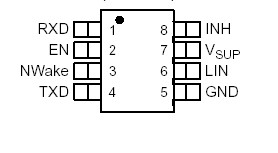TPIC1021: Features: LIN Physical Layer Specification Revision 2.0 compliant. Conforms to SAEJ2602 Recommended Practice for LIN LIN Bus Speed up to 20 kbpsESD Protection to 12 kV (Human Body Model) on LIN PinL...
floor Price/Ceiling Price
- Part Number:
- TPIC1021
- Supply Ability:
- 5000
Price Break
- Qty
- 1~5000
- Unit Price
- Negotiable
- Processing time
- 15 Days
SeekIC Buyer Protection PLUS - newly updated for 2013!
- Escrow Protection.
- Guaranteed refunds.
- Secure payments.
- Learn more >>
Month Sales
268 Transactions
Payment Methods
All payment methods are secure and covered by SeekIC Buyer Protection PLUS.

 TPIC1021 Data Sheet
TPIC1021 Data Sheet








